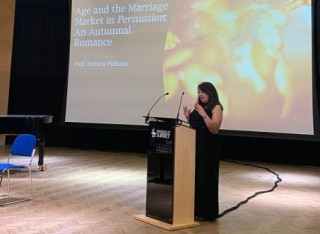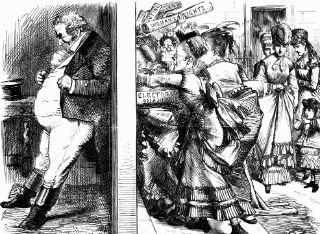
Dr Charlotte Mathieson
About
Biography
I am a Senior Lecturer in 19th-century English literature. I specialise in Victorian literature and culture, with an interest in travel and mobility in the mid-nineteenth century novel, focusing on authors including Dickens, Eliot, Gaskell and Charlotte Bronte. My publications include a monograph, Mobility in the Victorian Novel: Placing the Nation (Palgrave Macmillan, 2015), and the edited collections Mobilities, Literature, Culture (Palgrave, 2019), Sea Narratives: Cultural Responses to the Sea, 1600-present (Palgrave Macmillan, 2016) and Gender and Space in Rural Britain, 1840-1920 (Pickering and Chatto, 2014). I am co-editor of Palgrave Studies in Mobilities, Literature and Culture.
I was a British Academy Mid-Career Fellow 2022-23, working on a project titled "Cultures of Suntanning in late 19th to mid 20th century Britain".
I joined Surrey in 2016, having previously worked as a Teaching Fellow in the School of English Literature, Language and Linguistics at Newcastle University (2015-16) and Research Fellow at Warwick's Institute of Advanced Study (2012-15). I gained my PhD in the Department of English and Comparative Literary Studies at the University of Warwick in 2011.
Areas of specialism
University roles and responsibilities
- Director of Studies for English Literature and Creative Writing
- FABSS Representative, University Senate
My qualifications
Affiliations and memberships
News
In the media
ResearchResearch interests
My research has focused upon establishing a historical and theoretical basis of mobilities studies in the nineteenth century, including in my monograph Mobility in the Victorian Novel: Placing the Nation (Palgrave Macmillan, 2015). I am the editor of 3 collections, most recently Mobilities, Literature, Culture (Ed. with Marian Aguiar, Lynne Pearce; Palgrave Macmillan, 2019). My research has recently been funded through the award of British Academy Small Research Grant (2017-2019), and a British Academy Mid-Career Fellowship from September 2022-23, for my project "Cultures of Suntanning in late 19th to mid 20th century Britain".
I have been instrumental in developing the field of literary mobilities studies, internationally and within the UK: I am co-editor of Palgrave Studies in Mobilities, Literature and Culture, co-lead Surrey’s Mobilities in Literature and Culture Research centre, co-convene the Institute of Historical Research Transport and Mobility History Seminar, and am on the editorial board of Transfers.
I am also leading collaborations in the field of skin studies, and with Dr Nicole Nyffenegger (Bern), co-convene the international Cultural Skin Studies network.
I was awarded the Vice Chancellor’s Award for Researcher of the Year 2022.
Selected recent talks:
Keynote presentation. “From ‘seaside girls’ to ‘the sun-tanning crowd’: Cultures of Suntanning in Britain, c.1900-1940”. Literatures & Medicines symposium, Bournemouth University, April 2025.
Keynote: “Cultures of Suntanning: new dialogues between medical, cultural and commercial histories in 19th and 20th century Britain.” Faculty of Arts and Social Sciences Festival of Research, FASS Researcher of the Year Keynote Talk. 25th January 2023.
Respondent: IAS Talking Points Seminar: Dr Asha Hornsby, ‘Contagious Crossings: Representing Seafaring and Disease…’. Institute of Advanced Study, UCL, 12 January 2023.
“The textured language of tanned and burnt skin in 19th century culture.” Invited paper. Liminal Matters: Textures in 19th century Material and Literary Cultures. University of Konstanz, September 2022.
“Decolonising the geographies of nation and empire in Victorian studies teaching and research.” BAVS panel on “Decolonising Victorian studies”, English Shared Futures conference, 8th-9 July 2022, Manchester.
“Sunburnt at Sea: developing understandings of sunburn and tanning in 19th-century maritime medicine.” Invited paper. Locating Intersections Of Medicine and Mobility in 19th-century Britain, Friedrich-Alexander University, Germany, October 2019.
Public engagement
British Academy Summer Showcase 2024: exhibit, “Sensing Sunscreen: the curious history of a familiar product”, 12-13 July 2024
Pint of Science Festival 2023: “Scorched by the sun? Sun care through the centuries”, at the Star Inn Guildford, 23 May 2023
Public Talk at Beeston library, Nottingham: “On the Crest of the Heatwave: suntanning at Boots, 1900-1950s”, 21 June 2023
Research interests
My research has focused upon establishing a historical and theoretical basis of mobilities studies in the nineteenth century, including in my monograph Mobility in the Victorian Novel: Placing the Nation (Palgrave Macmillan, 2015). I am the editor of 3 collections, most recently Mobilities, Literature, Culture (Ed. with Marian Aguiar, Lynne Pearce; Palgrave Macmillan, 2019). My research has recently been funded through the award of British Academy Small Research Grant (2017-2019), and a British Academy Mid-Career Fellowship from September 2022-23, for my project "Cultures of Suntanning in late 19th to mid 20th century Britain".
I have been instrumental in developing the field of literary mobilities studies, internationally and within the UK: I am co-editor of Palgrave Studies in Mobilities, Literature and Culture, co-lead Surrey’s Mobilities in Literature and Culture Research centre, co-convene the Institute of Historical Research Transport and Mobility History Seminar, and am on the editorial board of Transfers.
I am also leading collaborations in the field of skin studies, and with Dr Nicole Nyffenegger (Bern), co-convene the international Cultural Skin Studies network.
I was awarded the Vice Chancellor’s Award for Researcher of the Year 2022.
Selected recent talks:
Keynote presentation. “From ‘seaside girls’ to ‘the sun-tanning crowd’: Cultures of Suntanning in Britain, c.1900-1940”. Literatures & Medicines symposium, Bournemouth University, April 2025.
Keynote: “Cultures of Suntanning: new dialogues between medical, cultural and commercial histories in 19th and 20th century Britain.” Faculty of Arts and Social Sciences Festival of Research, FASS Researcher of the Year Keynote Talk. 25th January 2023.
Respondent: IAS Talking Points Seminar: Dr Asha Hornsby, ‘Contagious Crossings: Representing Seafaring and Disease…’. Institute of Advanced Study, UCL, 12 January 2023.
“The textured language of tanned and burnt skin in 19th century culture.” Invited paper. Liminal Matters: Textures in 19th century Material and Literary Cultures. University of Konstanz, September 2022.
“Decolonising the geographies of nation and empire in Victorian studies teaching and research.” BAVS panel on “Decolonising Victorian studies”, English Shared Futures conference, 8th-9 July 2022, Manchester.
“Sunburnt at Sea: developing understandings of sunburn and tanning in 19th-century maritime medicine.” Invited paper. Locating Intersections Of Medicine and Mobility in 19th-century Britain, Friedrich-Alexander University, Germany, October 2019.
Public engagement
British Academy Summer Showcase 2024: exhibit, “Sensing Sunscreen: the curious history of a familiar product”, 12-13 July 2024
Pint of Science Festival 2023: “Scorched by the sun? Sun care through the centuries”, at the Star Inn Guildford, 23 May 2023
Public Talk at Beeston library, Nottingham: “On the Crest of the Heatwave: suntanning at Boots, 1900-1950s”, 21 June 2023
Supervision
Postgraduate research supervision
Completed:
Catherine Peck: “The Country Cottage in nineteenth-century literature” (primary supervisor)
Michelle Rushefsky: “Horror Capriccios: (Re)Imagining British Nineteenth-Century Fiction through the Veil of American Horror” (primary supervisor)
Alicia Barnes: “The Iron Arm of Empire: Railways, Imperialism and the Tensions of English Identity in Nineteenth-Century Literature” (primary supervisor)
Teaching
In 2025-26 I am teaching:
ELI1025 Understanding the Novel
ELI3066 Mobilities of Nation and Empire: Victorian literature 1850-90
ELIM061 Cultural Encounters in the 19th century
ELIM062 Forms and Genres
Publications
Mobility in the Victorian Novel explores mobility in Victorian novels by authors including Charles Dickens, Charlotte Brontë, Elizabeth Gaskell, George Eliot and Mary Elizabeth Braddon.
This line from George Eliot's 1859 novel Adam Bede, reflecting on the thoughts of young, naïve country girl Hetty Sorrel as she falls in love with the older, wiser and wealthier gentleman Captain Arthur Donnithorne, provides an indicative point from which to begin a discussion of sex, courtship and marriage in Victorian literature and culture, opening up many of the ideological tensions and wider cultural resonances that these terms and their intersections produced. In the naïvety of Hetty's innocent unknowing and shapeless expectations, Eliot signals the problem of ignorance about sex prevalent among young women in the period; in the assertion that ‘a novel' would provide Hetty with a guide to understanding, we are reminded of the centrality of courtship and marriage in structuring many novels of the period, as well as the cultural work that literature played in ‘shaping' the ideas of its readers
Interrogating the multiple ways in which travel was narrated and mediated, by and in response to, nineteenth-century British travelers, this interdisciplinary collection examines to what extent these accounts drew on and developed existing tropes of travel. The three sections take up personal and intimate narratives that were not necessarily designed for public consumption, tales intended for a popular audience, and accounts that were more clearly linked with discourses and institutions of power, such as imperial processes of conquest and governance. Some narratives focus on the things the travelers carried, such as souvenirs from the battlefields of Britain’s imperial wars, while others show the complexity of Victorian dreams of the exotic. Still others offer a disapproving glimpse of Victorian mores through the eyes of indigenous peoples in contrast to the imperialist vision of British explorers. Swiss hotel registers, guest books, and guidebooks offer insights into the history of tourism, while new photographic technologies, the development of the telegraph system, and train travel transformed the visual, audial, and even the conjugal experience of travel. The contributors attend to issues of gender and ethnicity in essays on women travelers, South African travel narratives, and accounts of China during the Opium Wars, and analyze the influence of fictional travel narratives. Taken together, these essays show how these multiple narratives circulated, cross-fertilised, and reacted to one another to produce new narratives, new objects, and new modes of travel.
The essays in this collection focus on the ways rural life was represented during the long nineteenth century. Contributors bring expertise from the fields of history, geography and literature to present an interdisciplinary study of the interplay between rural space and gender during a time of increasing industrialization and social change.
Data collected in the project "Cultures of Suntanning in late 19th to mid-20th century Britain", British Academy Mid-Career Fellowship award number MCFSS22\220038. Archive Dataset lists identifying details for all archive resources that were consulted during the project, with a note as to whether data was collected from each source. Literary dataset lists identifying details for all literary resources consulted during the project, including digital concordances where used, with a note as to whether data was collected from each source. The raw data collected cannot be made open access due to archive/copyright restrictions. The identifying details provide enough supplementary information for researchers to locate these resources.
The collection uses the concept of the ‘sea narrative’ as a lens through which to consider the multiple ways in which the sea has shaped, challenged, and expanded modes of cultural representation to produce varied, contested and ...
This article situates Charlotte Brontë’s writing within the context of mid-nineteenth century discourses of gender and travel, and posits that Brontë contributes to the discursive construct of the flâneuse through her writing about women walking the city in her letters from Belgium and in the novel Villette (1853). Through a critical framework drawing together literary historicism on women in the Victorian city and mobilities theories of embodied and sensory movement, the analysis reveals how Brontë foregrounds the experience of the body in her writing of women walking, and uses this as a mode through which to explore gendered discourses of mobility, and especially women’s urban walking. It argues that Brontë offers a new model of female urban spectatorship which privileges the body of the flâneuse as the prime site of knowing the city; this positively reconfigures the possibilities for autonomy and agency that urban walking affords, while at the same time making the body a site through which ambivalence about women’s mobility is expressed. The article reveals Charlotte Brontë to be a writer actively engaged with discourses of mobility and modernity that have been overlooked in her work, and situates Brontë as a significant contributor to debates about women and the city. It advances literary histories of city walking by locating Villette as a key participant within the field, and contributes to Brontë studies by revealing new perspectives on the significance of women’s travel in her works.
This article argues that despite apparently being the most ‘national’ of his novels, Bleak House is actively engaged with mid-nineteenth-century global travel culture and that reading the text through its mobile structures offers a productive framework through which to reconsider the novel's nation-building practices. It explores the relationship between space, mobility, and social relations in the novel, reading Dickens's employment of mobile structures in the text as evidence of a deep anxiety about the preserve of national place in an era of global modernity and revealing the impossibility of denying Britain's inextricable connection to the modern world.
Project report by Dr Charlotte Mathieson, University of Surrey. The report formed part of a British Academy funded mid-career fellowship award. The report describes Dr Matthieson's findings within the Boots archive and describes the social influences on the culture of suntanning in the early 20th century.
The introduction takes as its focus the book’s subtitle, ‘Cultural Responses to the Sea’, and aims to understand the relationship between culture and the sea, and to define the concept of the ‘sea narrative’ that forms this volume’s core. It begins by situating the book’s unique study of sea narratives within the field of cultural histories of the sea, discussing processes of narration, the relationship between different cultural forms, and the idea of sea narrative that is posited in the subsequent chapters. It then considers the transcultural scope of the collection and explores how the contributions work within national and transnational contexts, and draws out transnational connections that emerge across the volume as a whole.
Transport in British Fiction is the first essay collection devoted to transport and its various types horse, train, tram, cab, omnibus, bicycle, ship, car, air and space as represented in British fiction across a century of unprecedented technological change that was as destabilizing as it was progressive.
The essays in this collection focus on the ways rural life was represented during the long nineteenth century. Contributors bring expertise from the fields of history, geography and literature to present an interdisciplinary study of the interplay between rural space and gender during a time of increasing industrialization and social change.
Long held as Britain's 'national poet', Shakespeare's role in the 2012 London Cultural Olympiad confirmed his status as a global icon in the modern world. From his prominent positioning in the Olympic and Paralympic ceremonies, to his major presence in the cultural programme surrounding the Games, including the Royal Shakespeare Company's World Shakespeare Festival and the Globe's Globe to Globe Festival, Shakespeare played a major role in the way the UK presented itself to its citizens and to the world. This collection explores the cultural forces at play in the construction, use and reception of Shakespeare during the 2012 Olympic Moment, considering what his presence says about culture, politics and identity in twenty-first century British and global life.
This paper explores the materiality of skin as it is figured and re-figured through sunburn and suntanning descriptions in nineteenth-century culture. In nineteenth-century literary representations, the suntanned skin of white, British subjects is depicted through a rich array of terminology attending not only to the transformation of colour but also to the surface texture of the skin. This article identifies that, amid changing ideas about the embodiment of self within the skin, suntanning representations bring to the surface a particular ambivalence around the stability of the skin that manifests through explorations of the reconfiguration of the skin surface. The article analyses the language of suntanning to explore, firstly, how the action of sunburn and tanning reveals the skin as unstable and susceptible to the invasive actions of the sun, endangering the boundary-lines of the physical and conceptual self; and, secondly, instances in which suntanned skin is conceptualised through likeness to material objects in a way that metaphorically and conceptually hardens the skin and self against the wider world.

